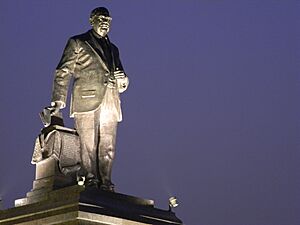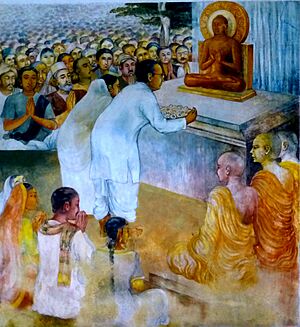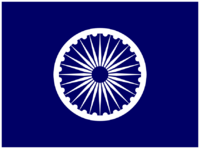Dalit Buddhist movement facts for kids
|
Basic terms |
|
|
People |
|
|
Schools |
|
|
Practices |
|
|
study Dharma |
|
The Dalit Buddhist movement is a special religious and social movement in India. It was started by B. R. Ambedkar for Dalit people. Dalits were once called "untouchables" and faced unfair treatment. This movement re-imagined Buddhism and created a new path called Navayana. It aims to make Buddhism a way to bring about social and political change.
The movement began in 1956 when Ambedkar and almost half a million Dalits converted to Navayana Buddhism. They chose this path to reject the old caste system in India and fight for Dalit rights. This new form of Buddhism also changed some ideas from older Buddhist traditions like Mahayana and Theravada. It focuses on being an "engaged Buddhism," meaning it actively works for social justice.
Contents
History of Buddhism in India
Buddhism started in ancient India. It grew a lot after Ashoka, a powerful king, supported it. By the 2nd century CE, Buddhism was popular in India and had spread to other parts of Asia.
Over time, Buddhism slowly became less common in India. By the 1200s, it had almost disappeared. Many Buddhist monks had to flee to places like Tibet to escape danger. Others moved to Hindu kingdoms in southern India.
In the 1800s, people started trying to bring Buddhism back to India. A Buddhist leader from Sri Lanka, Anagarika Dharmapala, created the Maha Bodhi Society. However, this group mostly attracted upper-caste Hindus, not Dalits.
Early Dalit Buddhist Efforts
Two important movements that rejected Hinduism for Buddhism were started in northern India. These were led by Swami Achhutanand Harihar in Uttar Pradesh and Babu Mangu Ram in Punjab.
Achhutanand was born into an "untouchable" family. He later left a reform group because he felt it still practiced untouchability. He then started his own movement. He told Dalits to return to "Adi-Dharma," which he called the "original religion of Indians." He believed this would unite Dalits and tribal groups.
Babu Mangu Ram was also born into an "untouchable" family in Punjab. He traveled to the United States and joined a group fighting British rule. Later, he focused on Dalit freedom. He started the "Ad Dharm" movement and a newspaper to share his ideas. He later joined Ambedkar's movement.
In southern India, Pandit Iyothee Thass started the Sakya Buddhist Society in Tamil Nadu in 1898. He offered Buddhism as a new religious choice for Dalits. His work led to a bigger movement among Tamil Dalits. Unlike Ambedkar's later movement, Thass's group followed the Theravada tradition of Buddhism from Sri Lanka.
B. R. Ambedkar: A Champion for Dalits

B. R. Ambedkar was a very important Indian leader. He lived during British rule and after India became independent. He was born into a Dalit family, who were among the most oppressed people in India. Even though his family was poor, he studied abroad. When he returned to India in the 1920s, he joined the political movement. He focused on getting social and political rights for Dalits.
In the early 1930s, the Indian independence movement, led by Mahatma Gandhi, talked with the British government. They discussed how India could become self-governing. The British wanted to keep India as a colony. They suggested new laws that would create separate voting groups based on religion and social divisions. They invited leaders from different groups, including Ambedkar, to represent the "untouchables."
Gandhi strongly disagreed with these separate voting groups. He feared they would divide people and make it harder for India to become truly free. When the British government passed a law for a separate voting group for untouchables, Gandhi started a fast. This led to a public outcry. The government, with Ambedkar's help, replaced the law with a compromise called the Poona Pact.
Ambedkar accepted the Poona Pact because of public pressure. However, he disagreed with Gandhi's methods. He believed Dalits needed to leave Hinduism to gain true equality. In 1935, he announced his plan to leave Hinduism. He thought about Islam, Christianity, Sikhism, Zoroastrianism, and Buddhism. Many religious leaders tried to convince him to join their faith.
Ambedkar eventually chose Buddhism. But he remained a Hindu for 20 more years. During this time, he studied and re-interpreted Buddhism. He created his own version, called Navayana, just weeks before he passed away.
Ambedkar believed that some traditional Buddhist ideas were not truly from the Buddha. He felt that concepts like the Four Noble Truths and Anatta (no-self) might have been added later. He also saw ideas like Karma and rebirth as superstitions.
Navayana, as taught by Ambedkar, changed many traditional Buddhist practices. It moved away from ideas like monks giving up everything, karma, rebirth, meditation, and nirvana. Ambedkar's new form of Buddhism focused on social equality and fighting for justice.
Ambedkar called his version of Buddhism Navayana or Neo-Buddhism. His book, The Buddha and His Dhamma, is the main book for Navayana Buddhists. For many followers, Ambedkar himself has become a very respected figure, almost like a deity.
Ambedkar's Conversion
After writing many books and articles about Buddhism being the path to equality for "untouchables," Ambedkar publicly converted. This happened on October 14, 1956, at Deekshabhoomi, Nagpur. It was over 20 years after he first said he would convert.
About 365,000 of his followers converted to Buddhism with him at the same ceremony. Many upper-caste Hindus also became Buddhists that day. Two days later, Ambedkar led another conversion ceremony for over 300,000 followers in Chandrapur. Inspired by this, 5,000 Tamils in Myanmar also accepted Buddhism.
Ambedkar told Dalits not to get caught up in the older forms of Buddhism (Theravada, Mahayana, and Vajrayana). He called his version Navayana or 'Neo-Buddhism'. Ambedkar passed away less than two months later, after finishing his important work on Buddhism.
Many Dalits call this movement "Ambedkar(ite) Buddhism." Many people who converted call themselves "-Bauddha," meaning Buddhists.
Twenty-two Vows
The Movement After Ambedkar
Ambedkar's death so soon after his conversion slowed the Buddhist movement a bit. It didn't get as much immediate support as he had hoped. Also, leaders of the movement sometimes disagreed, which made things harder.
According to the 2011 census, there are about 8.44 million Buddhists in India. Most of them (around 6.5 million) are Marathi Buddhists in Maharashtra, Ambedkar's home state. Buddhism is the fifth-largest religion in India. It makes up 6% of Maharashtra's population, but less than 1% of India's total population.
The Buddhist revival is strongest in two states: Maharashtra and Uttar Pradesh.
Developments in Uttar Pradesh

After Ambedkar's death, some leaders continued the work. Acharya Medharthi, an early Buddhist preacher, retired in 1960. He later returned to the Arya Samaj and performed Hindu ceremonies.
Rajendranath Aherwar became an important Dalit leader in Kanpur. He converted to Buddhism with his family in 1961. He founded a branch of the "Bharatiya Buddh Mahasabha." He held regular meetings, taught Buddhism, and organized festivals celebrating Ambedkar and Buddhist events.
The Dalit Buddhist movement in Kanpur grew more when Dipankar, a Buddhist monk, arrived in 1980. He helped organize a large conversion event in 1981. The number of Buddhists in Lucknow district grew from 73 in 1951 to 4327 in 2001. Most Buddhists in Uttar Pradesh are from Scheduled Castes (Dalit backgrounds).
In 2002, Kanshi Ram, a popular political leader, announced he would convert to Buddhism in 2006. He planned for 20 million of his supporters to convert with him. This was important because his followers included people from different castes, not just Dalits. However, he passed away in 2006 before the conversion.
Another important Dalit leader, Mayawati, has also said that she and her followers will become Buddhists if her party forms the government.
Maharashtra
Surai Sasai, a Japanese Buddhist leader, became very important in India. He came to India in 1966. He met Wamanrao Godbole, who had organized Ambedkar's conversion ceremony in 1956. Sasai felt a strong connection to Ambedkar and began building Buddhist temples (viharas) in Nagpur. He was later granted Indian citizenship.
Another important group is the Triratna Bauddha Mahāsaṅgha. It is the Indian part of a UK-based Buddhist community. This group works with Ambedkarites in India to help Indian Buddhism grow. They do social work through a trust and teach Buddhist principles.
Money for the movement's social and religious work has come from other countries, including Western nations and Taiwan.
Mass Conversions Today
Since Ambedkar's conversion, many thousands of people from different castes have converted to Buddhism. These ceremonies often include taking the twenty-two vows.
- In 1957, Bhante Pragyanand led a large conversion for 15,000 people in Lucknow.
- In 2001, Udit Raj, a Buddhist leader, organized a big conversion event.
- In 2006, a newspaper reported that some Hindus converted to Buddhism in Hyderabad. Buddhist monks from other countries attended.
- Also in 2006, hundreds of people converted in Gulburga (Karnataka).
- In 2007, tens of thousands of Dalits gathered in Mumbai to mark 50 years since Ambedkar's conversion.
Some people have criticized mass conversions as being more about politics than religion. However, these events continue to be an important part of the Dalit Buddhist movement.
See also
- The Buddha and His Dhamma
- Marathi Buddhists
- Buddhist Society of India
- Lord Buddha TV
- Namantar Andolan
- Chaitya Bhoomi
- Bhadant Anand Kausalyayan
- Bhadant Nagarjun Arya Surai Sasai
- Buddhism in India
- Buddhism in Nepal
- Buddhism in Sri Lanka
- Buddhist modernism
- Humanistic Buddhism
- New religious movement
- List of converts to Buddhism from Hinduism





